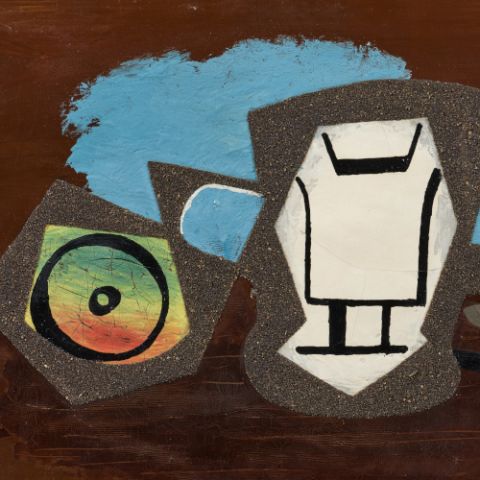
Lot 25 | Konrad Klapheck | "Die zahlreiche Familie"
Düsseldorf 1935 - 2023
Title: "Die zahlreiche Familie".
Date: 1961.
Technique: Oil on canvas.
Measurement: 75,5 x 80cm.
Notation: Signed verso centre: Klapheck. Titled verso upper centre on stretcher: Die zahlreiche Familie. Next to it is a label by the artist with handwritten work details.
Frame/Pedestal: Framed.
The work is listed in the artist's handwritten catalogue raisonné (1990) under number 74.
An original handwritten letter from Konrad Klapheck to the current owner dated 1st December 1990 is available for the work.
Provenance:
- Galerie Schwarz, Milan 1963
- Claude Bernard Gallery, Paris
- Sothebys London, auction 4th April 1974
- Löwenstein Collection, London
- Gallery Elke Dröscher, Hamburg
- Mrs Budenhölzer, Heidelberg
- Private collection Germany (1990)
Exhibitions:
- Galleria Schwarz, Milan 1963 (label, here titled: La Familie Nombreuse)
- Kestner Society, Hanover 1966
- Kunst und Museum Association Wuppertal, 1967, cat. no. 74
- Institute for Modern Art, Nuremberg 1970, cat. no. 74
- Kunsthalle Hamburg, 1985
Literature:
- Exhib. cat. Galleria Schwarz, Milan 1963, no p.
- Exhib. cat. Kestner Gesellschaft, catalogue 2 exhibition year 1966/67 Konrad Klapheck, Hanover 1966, cat. No. 74
- Exhib. cat. Kunst und Museumsverein Wuppertal, 1967, cat. No. 74
- Exhib. cat. Institute for Modern Art Nuremberg 1970, Cologne 1970, cat. No. 74
- Significant early work that is unique in Klapheck's oeuvre with its proximity to abstraction
- Radical setting through a strictly simplified pictorial composition
- Painting of high topicality and explosiveness
An extraordinary work
The painting “The numerous family” is an important early work by Konrad Klapheck, which he painted at a time when he was still developing his pictorial vocabulary. The predominant forms in this painting are twelve highly simplified, rounded blocks that take up the entire pictorial space in a serial sequence. Klapheck formed them by reducing the motif of bicycle bells, which play a central role in paintings such as “My Sixteen Fears” (1958, fig. 1), “Genealogy” (1960, fig. 2) or “Alphabet of Passion” (1961). The serial arrangement of the twelve forms in three rows of four elements each also refers to the keys on a typewriter, which in many of the artist's other paintings allude to dictatorial power relations and systems of rule, such as in the paintings “The Ancestors” (1960) or “The Ideals of the Fathers” (1966). In a letter dated November 28, 1990, to a previous owner of the painting “The Numerous Family,” the artist described how he came up with his motif: “You may know the motif of the bicycle bell from literature, which I divided into two different color zones for purely aesthetic reasons, creating the impression of a landscape seen through a round window. The bells, arranged in a grid-like pattern in places, became increasingly simplified, the mechanism was dropped, leaving round blocks on which I in turn placed empty bicycle bell housings. The landscape subdivision remained.” (Konrad Klapheck, letter to the previous owner, November 28, 1990) The starkly simplified pictorial composition makes Klapheck's painting a radical statement that anticipates the principles of American Minimal Art. Within Klapheck's oeuvre, this painting is unusual in its proximity to abstraction.
The significance of the bicycle bell
Klapheck's painting is not only conceptually charged by its title. When it was shown in the artist's exhibition at the Kestner Gesellschaft in Hanover in 1966, Klapheck published his 1963 text “The Machine and I” in the catalog, in which he described the iconographic field of meaning of bicycle bells and the formal elements developed from them: “The bicycle bell, laden with memories of the first bicycle of my childhood, deals with life in the family and in the community. It usually appears in the plural, rigidly connected to its comrades, like in a regiment, in whose forced order under the uniforms of the same color, such different longings torment the heart, or like the monotonous slabs of a war cemetery, that sad caricature of the community into which death forces us.” (Konrad Klapheck, “Die Maschine und ich” (1963), quoted in: Heymer, Kay / Wismer, Beat (eds.): Klapheck - Bilder und Texte, Munich 2013, p. 27.) Beneath the flawless, smooth surface and perfectly painted forms in Klapheck's painting, there is an emotional passion that results from his reflection on historical knowledge and the dark abysses of the inadequate reappraisal of Nazi fascism by the Federal Republic of Germany's economic miracle in the 1950s. Even if Klapheck's early success in the circle of post-war Paris Surrealists seemed to overshadow his topicality and explosive nature, works such as his fascinating painting “Die zahlreiche Familie” (The Large Family) show that he was very much in touch with the times, both aesthetically and socially, and was able to preserve his topicality.
Kay Heymer.
Modern, Post War & Contemporary Art
+49 221 92 58 62 300
Print this lot | Recommend lot |
Conditions of this Lot
32% buyer’s premium on the hammer price
Estimated shipping costs for this lot:
Arrangement after the auction.
Konrad Klapheck Germany Hyperrealism Post-War Art Post War 1960s Framed Families Painting Oil Engine
More lots which could be of your interest
- Estimate: 400 - 600 €Bid: 500 €3 Bid(s)17h:18m:44sNow and Then. Art of the 21st 20th Century | ONLINE ONLY | Auction 23.10.2025








